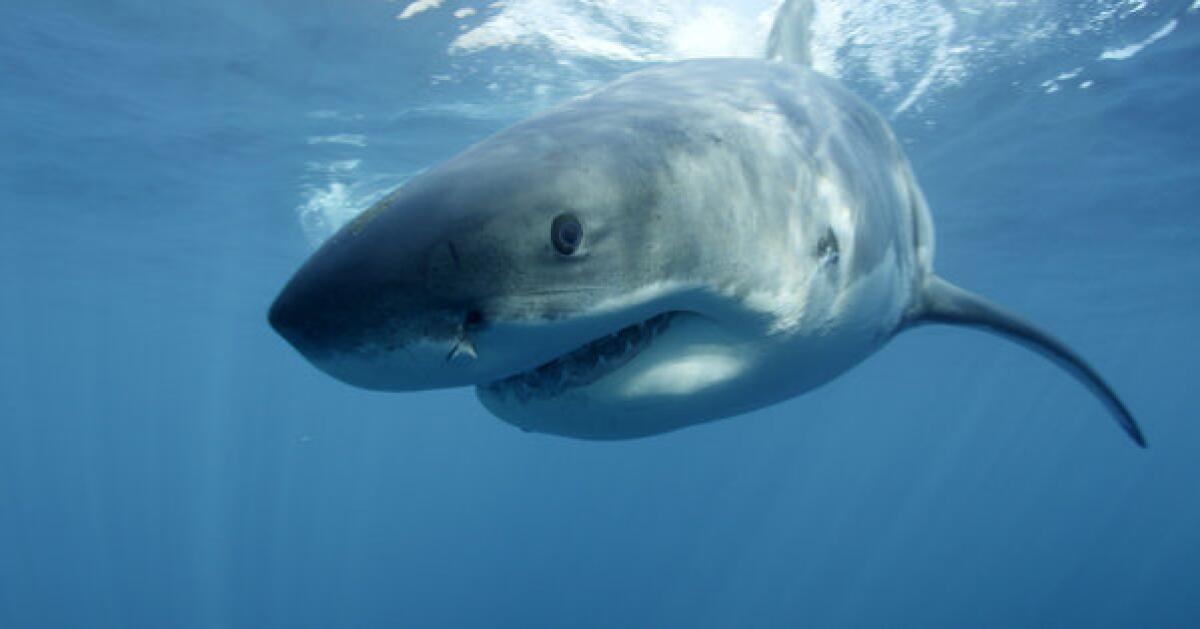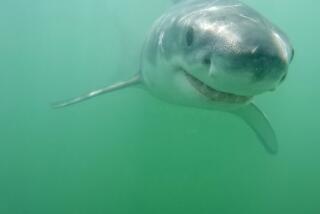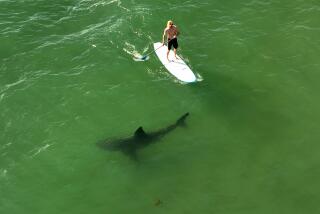A shark’s tale: Reading about great whites

- Share via
On Cape Cod, where I spent some time this summer, sharks became big business this year. The town of Chatham, Mass., sought to reinvent itself, “casting the shark as a town emblem, T-shirt punch line, and eco-icon,” Warren Cornwall wrote recently in the Boston Globe Sunday Magazine.
“Chatham as a town, I think, has embraced the whole shark concept,” Chamber of Commerce chief Lisa Franz told him. “As long as nobody gets hurt.” On Main Street, throughout the summer, “Jaws” showed at the local movie theater, even as great white sharks were sighted off the beach.
I couldn’t help thinking about this as I read, in the current issue of the New Yorker, Alec Wilkinson’s piece about the sharks of Massachusetts, “Cape Fear.” Wilkinson, of course, is one of the best nonfiction writers working, the author of a dozen books (my favorites are “Moonshine: A Life in Pursuit of White Liquor” and “The Happiest Man in the World: An Account of the Life of Poppa Neutrino”) and a staff writer at the New Yorker for more than 30 years.
The key to Wilkinson is that he zeroes in on unexpected subjects, moonshiners and mystics, people whose stories don’t ordinarily get told. “I do not believe,” he tells us in “The Happiest Man in the World,” “that someone is a proper subject, or a laudable figure, only if he has made a lot of money or been a politician, an actor, a freakish public figure, or a criminal. The eccentrics, the odds beaters, the benign connivers, the showmen, the pilgrims and the raffish self-glorifiers also have their place in the pageant.”
Such a principle is very much at work in “Cape Fear,” where Wilkinson moves from researchers seeking to tag sharks to a man named Chris Myers, who was bit by a great white off Truro in 2012, to the migratory patterns of the fish themselves. In that sense, it’s a classic Wilkinson piece, mixing history, reportage and a bit of personal reflection, beginning with the observation that, “[w]hen I was a child, growing up summers in Wellfleet, people said that there couldn’t be sharks in the water because the water was too cold.”
I remember this also, from my childhood summers on the Cape, although after “Jaws” was published, in 1974, I never went swimming in the ocean again. That novel — and the movie, filmed on Martha’s Vineyard and released the following year — changed how we think of sharks, and not for the better, Wilkinson suggests. “In the minds of many shark researchers,” he notes, “the movie was a setback to white-shark science. … Every shark since has been shot, hooked, or whacked, so now what we have is a very cautious fish.”
That’s an unexpected way of referring to great whites, which have a very different reputation: “the baddest fish in the ocean,” one researcher says. Just think of their nicknames: White death, man-eater or the more blandly menacing “men in the gray suits,” a reference to their white bellies and gray backs.
And yet, like all creatures, they adapt, which is why they’ve come to the Cape. “In 1990,” Wilkinson writes, “a white shark was seen off Cape Cod. Five years passed before another was sighted. Lobster divers in Provincetown said that they sometimes came face to face with them in the murky water off Race Point. In 1999, two were seen; one was seen in 2001, and four in 2005. Twenty-one were seen in 2012.”
The reason for this, Wilkinson suggests, is simple: “For parts of the nineteenth and twentieth centuries, Massachusetts and Maine paid a bounty for a seal nose. In 1972, the Marine Mammal Protection Act made it illegal to kill them, and now according to Lisa Sette, a biologist at the Provincetown Center for Coastal Studies, the seals ‘are in the midst of a recolonization process.’”
A researcher named Greg Scomal puts it another way: He “describes the seal aggregations as a café, and he says that now that the café is open ‘the men in the gray suits are showing up.’”
Here, we encounter Wilkinson at his finest: blending reportage and folklore, storytelling and fact. Why, he wants us to consider, do sharks compel us? Because they are implacable. “The appeal of white sharks to the imagination,” he writes, “is so obvious that it hardly needs stating, but, even so, like all big, fierce creatures, they exemplify the mysterious and ungovernable parts of our lives.”
ALSO:
Will James Franco please stop?
Missing the point on Jack Kerouac
Finding lost Philip Roth in a Provincetown used bookstore
More to Read
Sign up for our Book Club newsletter
Get the latest news, events and more from the Los Angeles Times Book Club, and help us get L.A. reading and talking.
You may occasionally receive promotional content from the Los Angeles Times.








